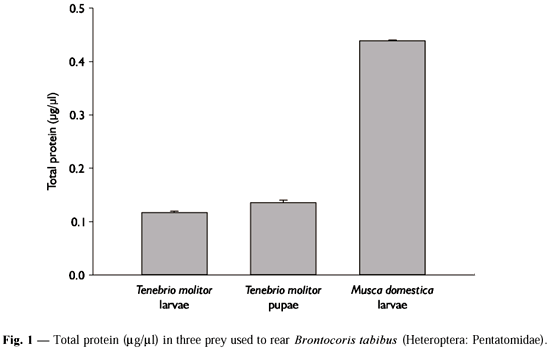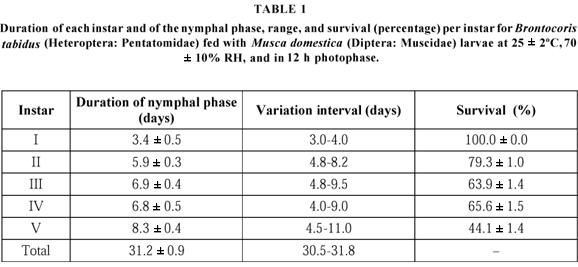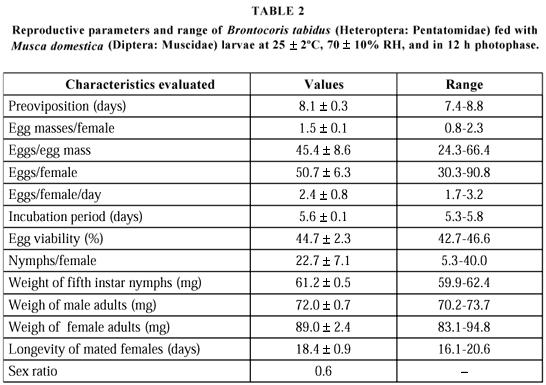Abstracts
Development and reproductive performance of Brontocoris tabidus (Signoret) (Heteroptera: Pentatomidae) fed with Musca domestica L. (Diptera: Muscidae) larvae was evaluated. Duration of the nymphal phase of this predator was 31.2 days, with a 44.1% survival rate. Preoviposition and egg incubation periods and number of eggs/egg mass were 8.14 days, 5.6 days, and 45.4, respectively. B. tabidus presented 44.7% egg viability. Female longevity of this predator was 18.4 days. Results are discussed based on this prey use in mass rearing and maintenance of colonies of B. tabidus under laboratory conditions.
Brontocoris tabidus; Musca domestica; reproduction; insect rearing
A performance reprodutiva e o desenvolvimento de Brontocoris tabidus (Signoret) (Heteroptera: Pentatomidae) alimentado com larvas de Musca domestica L. (Diptera: Muscidae) foram investigados. A duração da fase ninfal desse predador foi de 31,2 dias, com sobrevivência de 44,1%. Os períodos de pré-oviposição e de incubação e o número de ovos por postura foram de 8,14 dias, 5,6 dias e 45,4 dias, respectivamente. B. tabidus apresentou viabilidade de ovos de 44,7%. A longevidade das fêmeas desse predador foi de 18,4 dias. Esses resultados são discutidos com ênfase ao uso de M. domestica em criação massal e manutenção de colônias de B. tabidus em condições de laboratório.
Brontocoris tabidus; Musca domestica; reprodução; criação de inseto
Biology of Brontocoris tabidus (Heteroptera: Pentatomidae) fed with Musca domestica (Diptera: Muscidae) larvae
Biologia de Brontocoris tabidus (Heteroptera: Pentatomidae) alimentado com larvas de Musca domestica (Diptera: Muscidae)
Jusselino-Filho, P.I; Zanuncio, J. C.I; Fragoso, D. B.I; Serrão J. E.II; Lacerda, M. C.I
IDepartamento de Biologia Animal/BIOAGRO, Universidade Federal de Viçosa, CEP 36571-000, Viçosa, MG, Brazil
IIDepartamento de Biologia Animal, Universidade Federal de Viçosa, CEP 36571-000, Viçosa, MG, Brazil
Correspondence Correspondence to José Cola Zanuncio Departamento de Biologia Geral, Universidade Federal de Viçosa, CEP 36571-000, Viçosa, MG, Brazil e-mail: zanuncio@geral.ufv.br
ABSTRACT
Development and reproductive performance of Brontocoris tabidus (Signoret) (Heteroptera: Pentatomidae) fed with Musca domestica L. (Diptera: Muscidae) larvae was evaluated. Duration of the nymphal phase of this predator was 31.2 days, with a 44.1% survival rate. Preoviposition and egg incubation periods and number of eggs/egg mass were 8.14 days, 5.6 days, and 45.4, respectively. B. tabidus presented 44.7% egg viability. Female longevity of this predator was 18.4 days. Results are discussed based on this prey use in mass rearing and maintenance of colonies of B. tabidus under laboratory conditions.
Key words:Brontocoris tabidus, Musca domestica, reproduction, insect rearing.
RESUMO
A performance reprodutiva e o desenvolvimento de Brontocoris tabidus (Signoret) (Heteroptera: Pentatomidae) alimentado com larvas de Musca domestica L. (Diptera: Muscidae) foram investigados. A duração da fase ninfal desse predador foi de 31,2 dias, com sobrevivência de 44,1%. Os períodos de pré-oviposição e de incubação e o número de ovos por postura foram de 8,14 dias, 5,6 dias e 45,4 dias, respectivamente. B. tabidus apresentou viabilidade de ovos de 44,7%. A longevidade das fêmeas desse predador foi de 18,4 dias. Esses resultados são discutidos com ênfase ao uso de M. domestica em criação massal e manutenção de colônias de B. tabidus em condições de laboratório.
Palavras-chave:Brontocoris tabidus, Musca domestica, reprodução, criação de inseto.
INTRODUCTION
Biological control is an important method for reducing the dependence on chemical control and reestablishing the balance between pests and their natural enemies (Metcalf & Luckmann, 1982). The first of these, however, became the main method of pest control since the appearance of organic-synthetic insecticides in the 1940s. But the indiscriminate use of insecticides can cause negative impacts, including destruction of non-target insects such as predators, parasitoids, and pollinators, besides environmental contamination, human health problems, and pest resistance and resurgence (Metcalf & Luckmann, 1982; Guedes & Fragoso, 1999). These impacts have increased the use of biological control agents as part of pest management.
Natural enemies for biological control programs can be reared with natural, alternative prey or hosts, or artificial diets (Cohen, 1985). Pentatomidae predators have been reared and used against eucalyptus defoliating caterpillars such as Blera sp., Blera varana Schaus (Notodontidae); Eupseudosoma aberrans Schaus, Eupseudosoma involuta Sepp (Arctiidae); Glena spp., Thyrinteina arnobia Stoll (Geometridae); and Sarsina violascens (Herrich-Schaeffer) (Lymantriidae) in eucalyptus plantations in Brazil (Zanuncio et al., 1991, 1996, 1998; Saavedra et al., 1998). Brontocoris tabidus Signoret (Heteroptera: Pentatomidae) are reared in the laboratory and released to control these pests and others in eucalyptus plantations (Zanuncio et al., 1991; Jusselino-Filho et al., 2001).
For this reason, the purpose of this research was to study in the laboratory nymphal development and reproductive characteristics of B. tabidus fed with larvae of the alternative prey Musca domestica L. (Diptera: Muscidae).
MATERIAL AND METHODS
Adults of B. tabidus were collected in a plantation of Eucalyptus cloesiana and Eucalyptus urophylla of Refloralje (Reforestation, Farming, and Cattle Raising) in Montes Claros, State of Minas Gerais, Brazil, established in the laboratory, and fed with larva of M. domestica. The colony developed under 25 ± 2°C, 70 ± 10% RH, and in a 12 h photoperiod.
Adults of B. tabidus were maintained in 500 ml plastic cups with two holes in their covers. Each one had a 40 ml cup with its bottom substituted by nylon mesh where M. domestica larvae were supplied daily. In the other hole a 2 ml cylindrical plastic tube filled with water was placed.
Eggs of B. tabidus were maintened in Petri dishes (9.0 x 1.2 cm) with a moist cotton ball. These eggs were used to determine the incubation period and egg viability of B. tabidus. First instar nymphs of B. tabidus received only water through a moist cotton ball, because this species does not present predatory habits during this instar (Jusselino-Filho et al., 2001).
Samples of 10 second instar nymphs of B. tabidus were placed in 15 plastic cups (500 ml). Duration of each instar, and survival and weight of fifth instar B. tabidus nymphs were evaluated 24 hours after molt. Sex ratio; weight; preoviposition period; number of egg masses per female; number of eggs per egg mass; total number of eggs and eggs per female/day; and longevity of B. tabidus were evaluated during the adult stage.
One gram of M. domestica larvae and Tenebrio molitor L. (Coleoptera: Tenebrionidae) larvae and pupae were macerated in the presence of phosphate buffer 0.1 M, pH 7.5 with 0.3% Triton-X100 for protein determination. Samples were centrifugated at 8000 rpm at 4ºC for 15 min. using supernatant for protein determination according to Bradford (1976), with bovine serum albumine as the standard.
RESULTS AND DISCUSSION
Larvae of M. domestica presented higher levels of total protein (Fig. 1) than larvae and pupae of T. molitor.
Duration of first B. tabidus instar(Fig. 2) was similar to that reported by other authors for this predator. This was an expected result, because B. tabidus do not feed on prey during first instar in a way similar to that of most species of Pentatomidae predators (Barcelos et al., 1991; Jusselino-Filho et al., 2001).
B. tabidus fed with M. domestica larvaepresented longer duration of each first and of the entire nymphal phase (Table 1) when compared with those reared with other prey or on artificial diets (Zanuncio et al., 1996; Jusselino-Filho et al., 2001). Longer duration of the nymphal phase can be an advantage as it increases the period of feeding on caterpillars in outbreak conditions. On the other hand, it may represent a problem because lower duration of this phase is important for this predator in supplanting insect pests in number of individuals and generations which can contribute to faster reestablishment of the prey-predator balance.
Survival during the nymphal phase of B. tabidus reached 44.1% (Fig. 3) showing that it varies with prey type and nutritional quality, as found for Podisus maculiventris by De Clercq et al. (1998), suggesting that food quality can be more important than its quantity. This was also found by Stamp et al. (1997) who showed that food quality can interfere with the feeding period and survival rate of Pentatomidae predators. Thus, it appears that M. domestica larvae have lower nutritive quality than other prey.
Fifth instar nymphs and male and female adults of B. tabidus presented weights of 61.2 mg, 72.0 mg, and 89.0 mg, respectively (Table 2). These values are lower than those found for this predator fed with other prey (Jusselino-Filho et al., 2001).
Females of predatory Pentatomidae are heavier than the males and diet affects survival of their nymphs (Jusselino-Filho et al., 2001; Lemos et al., 2001). Females of these predators have lower weights when fed on artificial diet (De Clercq & Degheele, 1992; Saavedra et al., 1996), which thus shows a quality level inferior to that of alternative prey such as M. domestica larvae
B. tabidus presented preoviposition period of 8.1 days (Table 2), a value similar to those obtained by other authors using different prey (Barcelos et al., 1991; Jusselino-Filho et al., 2001). This shows that this characteristic is not affected by prey type.
Number of egg masses and eggs/egg mass of B. tabidus was 1.5 and 45.4, while the number of eggs/female and eggs/female/day was 50.7 and 2.4, respectively, with an incubation period and egg viability of 5.6 days and 44.7%, respectively (Table 2). These values are lower than those found with B. tabidus fed on larvae of B. mori and T. molitor (Zanuncio et al., 1996; Jusselino-Filho et al., 2001) which demonstrates the lower dietary quality of M. domestica larvae during the reproductive stage of B. tabidus. These results may, however, improve if this prey is used in combination with T. molitor, as was found for P. nigrispinus (Zanuncio et al., 2001).
Longevity of B. tabidus was 18.4 days for mated females, a result lower than those for this predator fed with B. mori larvae (Zanuncio et al., 1996) and agreeing with those of other authors who found that B. tabidus longevity varies according to prey type (Zanuncio et al., 1996; Jusselino-Filho et al., 2001).
Feeding of B. tabidus on larvae of M. domestica affected its life cycle, weight, and survival, with lower values for some biological parameters in relation to those for other preys. This shows that larvae of this prey have low nutritional quality which can affect weight, stored reserves, and reproductive success of this predator. The lesser performance of B. tabidus with M. domestica larvae shown here has been found for other species of predatory Pentatomidae fed with this prey such as Podisus nigrispinus Dallas (Heteroptera: Pentatomidae) which presented a longer nymphal period and lower egg production when on both an artificial diet and M. domestica larvae (Lemos et al., 2001).
In spite of its inexpensive rearing and higher total protein level as compared to T. molitor, larvae of M. domestica are not suitable prey for mass production of B. tabidus but is potential useful in maintaining this predator under laboratory conditions.
Acknowledgments We are grateful to the Conselho Nacional de Desenvolvimento Científico (CNPq); the Coordenação de Aperfeiçoamento de Pessoal de Nível Superior (CAPES); and the Fundação de Amparo à Pesquisa de Minas Gerais (FAPEMIG).
Received December 11, 2001
Accepted May 22, 2002
Distributed August 31, 2003
- BARCELOS, J. A. V., ZANUNCIO, J. C., SANTOS, G. P. & REIS, F. P., 1991, Viabilidade da criação, em laboratório, de Podisus nigrolimbatus Spinola, 1852 (Hemiptera: Pentatomidae) sobre duas dietas. Rev. Árv., 15: 316-322.
- BRADFORD, M. M., 1976, A rapid and sensitive method for quantification of microgram quantities of protein utilizing the principle of protein-dye binding. Anal. Biochem., 72: 248-254.
- COHEN, A. C., 1985, Simple method for rearing the insect predator Geocoris punctipes (Heteroptera: Lygaeidae) on a meat diet. J. Econ. Entomol., 78: 1173-1175.
- DE CLERCQ, P. & DEGHEELE, D., 1992, A meat-based diet for rearing the predatory stinkbugs Podisus maculiventris and Podisus sagitta (Heteroptera: Pentatomidae). Biol. Cont., 12: 137-142.
- DE CLERCQ, P., MERLEVEDE, F. & TIRRY, L., 1998, Unnatural prey and diets for rearing Podisus maculiventris (Het.: Pentatomidae). Entomophaga, 37: 133-139.
- GUEDES, R. N. C. & FRAGOSO, D. B., 1999, Resistência a inseticidas: bases gerais, situação e reflexões sobre o fenômeno em insetos-praga do cafeeiro, pp. 99-120. In: L. Zambolim (ed.), I Encontro sobre produção de café com qualidade UFV, Viçosa, 259p.
- JUSSELINO FILHO, P., ZANUNCIO, J. C., GUEDES, R. N. C. & FRAGOSO, D. B., 2001, Desarrollo y reproducción del depredador Brontocoris tabidus (Hemiptera: Pentatomidae) alimentado con larvas de Tenebrio molitor (Coleoptera: Tenebrionidae). Rev. Col. Entomol., 27: 45-48.
- LEMOS, W. P., MEDEIROS, R. S., RAMALHO, F. S. & ZANUNCIO, J. C., 2001, Effect of plant feeding on the development, survival, and reproduction of Podisus nigrispinus (Dallas) (Heteroptera: Pentatomidae). Inter. J. Pest. Manag., 47: 89-93
- METCALF, R. L. & LUCKMANN, W. H., 1982, Introduction to insect pest management John Wiley & Sons, New York, 328p.
- SAAVEDRA, J. L. D., ZANUNCIO, J. C., ZANUNCIO, T. V. & SANTOS, G. P., 1996, Desarrollo ninfal de Podisus nigrispinus (Dallas) (Hemiptera: Pentatomidae) en alimentación mixta de dieta artificial y larvas de Musca domestica (Diptera: Muscidae). Brenesia, 45-46: 177-182.
- SAAVEDRA, J. L. D., ZANUNCIO, J. C., ZANUNCIO T. V. & CANTOR, F., 1998, Dieta artificial con carne de res, hojas de mora (Morus alba), sales de Wesson y yema de huevo de gallina para Podisus nigrispinus (Hemiptera: Pentatomidae). Rev. Col. Entomol., 24: 13-16.
- STAMP, N. T., YANG, Y. & OSIER, T. L., 1997, Response of an insect predator to prey fed multiple allelochemicals under representative thermal regimes. Ecology, 78: 203-214.
- ZANUNCIO, J. C., BATISTA, L. G., ZANUNCIO, T. V., VILELA, E. F. & PEREIRA, J. F., 1991, Levantamento e flutuação populacional de lepidópteros associados à eucaliptocultura: VIII Região de Belo Oriente, Minas Gerais, junho de 1989 a maio de 1990. Rev. Árv., 15: 83-93.
- ZANUNCIO, J. C., SAAVEDRA, J. L. D., OLIVEIRA, H. N., DEGHEELE, D. & DE CLERCQ P., 1996, Development of the predatory stinkbug Brontocoris tabidus (Signoret) (Heteroptera: Pentatomidae) on different proportions of an artificial diet and pupae of Tenebrio molitor L. (Coleoptera: Tenebrionidae). Biocont. Sc. Technol., 6: 619-625.
- ZANUNCIO, T. V., TORRES, J. B., ZANUNCIO, J. C. & SANTOS, G. P., 1998, Ciclo de vida e reprodução de Podisus distinctus (Stal) (Heteroptera, Pentatomidae) alimentado com dois tipos de presas. Rev. Bras. Entomol., 41: 335-337.
- ZANUNCIO, J. C., MOLINA-RUGAMA, A. J., SERRÃO, J. E. & PRATISSOLI, D., 2001, Nymphal development and reproduction of Podisus nigrispinus (Heteroptera, Pentatomidae) fed combinations of Tenebrio molitor (Coleoptera: Tenebrionidae) pupae and Musca domestica (Diptera: Muscidae) larvae. Bioncont. Sc. Technol., 11: 331-337.
Publication Dates
-
Publication in this collection
20 Jan 2004 -
Date of issue
Aug 2003
History
-
Accepted
22 May 2002 -
Received
11 Dec 2001






